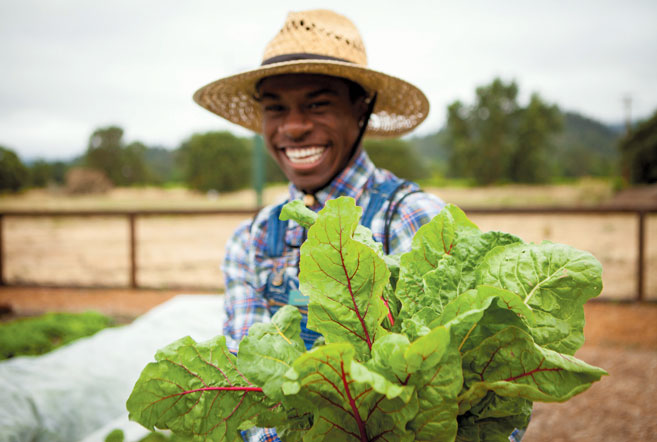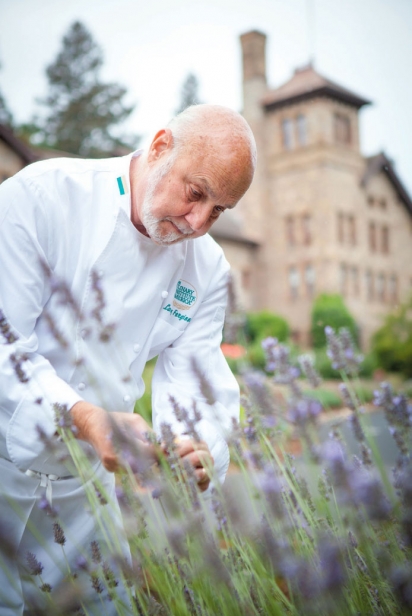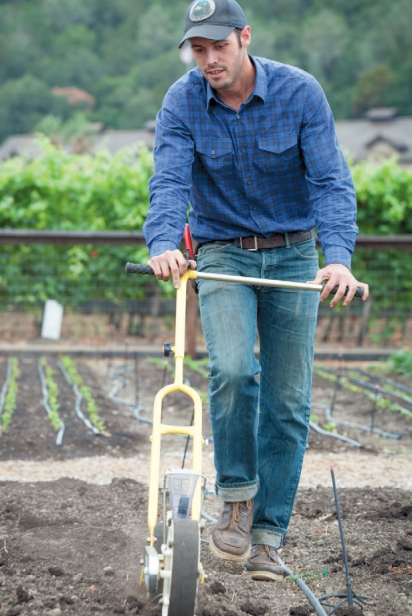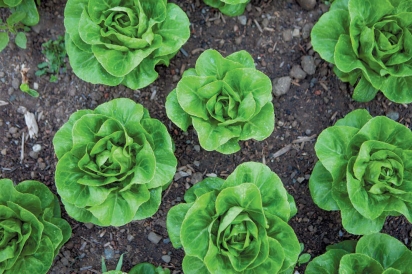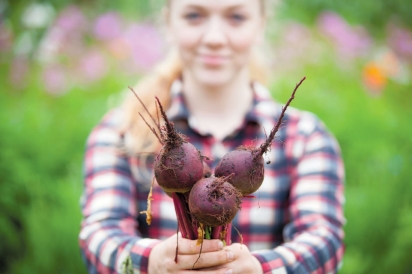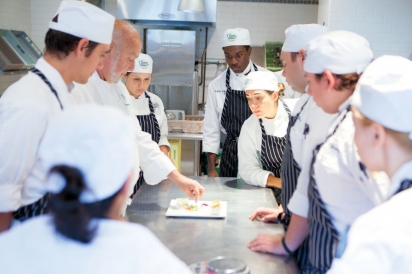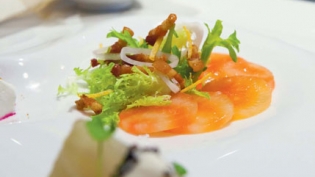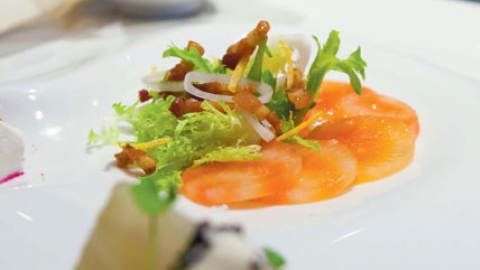The CIA at Greystone
Schooling the Next Generation of Farm-to-Table Chefs
When you are hailed as “the Godfather” of American cuisine, have earned three stars from the New York Times for your work as a chef, been named America’s Best Chef by the James Beard Foundation and Chef of the Year by the Culinary Institute of America (CIA), what comes next?
If you are Larry Forgione, you set out to change the way young chefs perceive the food movement widely referred to as “farm-to-table,” which defines your generation of chefs.
Forgione, a New York native and 1974 graduate of the CIA, is renowned for his work at New York City’s American Cafe and The River Cafe in Brooklyn, where his skill as a chef catapulted each restaurant into the limelight as he forged a nascent movement—cooking with outstanding ingredients sourced directly from local farms.
After more than 30 years in the restaurant business, Forgione tells me, he had a discussion with Jonathan Waxman, the Berkeley native and distinguished American chef in his own right, about what the next phase of his career might be. That conversation kindled an idea: He would teach young culinarians what “farm to table” really means. The majority of students currently attending cooking school were born in the 1990s and raised in a culture of chefs as TV personalities. Forgione sensed a dislocation.
“I wanted to infuse into them that the term ‘farm to table’ is not a marketing term dreamt up by a PR company in 1991,” says Forgione, “but a lifestyle and a spirit of cooking.”
Forgione, who came of age during the era of nouvelle cuisine, sees farm-to-table as an extension of that movement, which encouraged a simpler, more natural presentation of food than the classical, mid-century French dishes. And so, he sat down and, together with Waxman, wrote a culinary program, “The Conservatory of American Food Studies,” and planned to pitch it to universities. Instead, Forgione pitched it to CIA President Tim Ryan. By the end of lunch, Ryan was on board and the program had a home.
Launched in 2011 at the CIA’s Saint Helena campus, with Forgione as culinary director, the American Food Studies: Farm-to-Table Cooking curriculum is a 15-week program of 18 credits offered to seniors in the school’s Bachelor of Arts program. There are three distinct phases to the students’ studies: work on the CIA’s three small farms and at other nearby farms, classroom lectures and hands-on restaurant operations.
Each week during the program, the 24 or so students are asked to design a menu item for the five-course menu served at dinner on Friday and Saturday at the aptly named on-campus restaurant, The Conservatory. Forgione guides the students through their menu development using the core principle of cooking with what is currently available from the gardens as the overarching mission.
The process begins on Saturdays when Matt Gunn, the CIA’s farm manager, hands Forgione a sheet of what is expected for harvest during the upcoming week. Forgione then sits down with each student to go through this “fresh sheet” and discuss what local, ethically produced proteins they might also be able to procure. By Tuesday morning, students come back to Forgione with two menu ideas for their assigned course. Forgione queries the students about the integrity of their dish: What are the values of the ingredients on the plate? Does the idea celebrate the ingredients on the plate or overpower them? Since everything served at The Conservatory is made from scratch by the students, do they have all the needed ingredients—or can they prepare them—in time for service on Friday and Saturday?
Many dishes are “studies” or “progressions” of a single ingredient and are inspired by the life cycle of the plant itself. “Think about arugula,” prompts Forgione. “Micro, baby, adolescent—they are all good for salads, but what do you do with the mature leaves and shoots (or raab) when they go to seed?” Working with Gunn, Forgione has the students experience each stage of the plant in the field, then work with each version in the kitchen.
With The Conservatory restaurant as his primary market and the culinary school and its other restaurants as his secondary market, Gunn is tasked with developing the 2-year-old farm into an experiential laboratory and idea incubator as well as classroom and, well, productive farm. The farm, a patchwork of acreage on Peter Mondavi’s Charles Krug Winery situated mostly across the Saint Helena Highway from the Greystone campus, includes roughly three acres dedicated to annual vegetable production, three acres devoted to heritage wheat varietals, the “Herb Terrace” and the numerous fruit and olive trees that peer down on the parking area in front of the school.
The unique layout and mix of plants not only gives students the chance to see the life cycle of a wide array of flora, it also provides the space to grow simply for the experience of tasting, for educating young minds and palates. As an example, the school’s wheat field is planted to a mix of Sonoran White wheat and Emmer, a high-gluten varietal. This is an ideal crop blend for students to learn about differences in milling hard and soft varietals and, once milled, how these grains work together to create a delicious loaf of bread in the kitchen.
While Gunn works directly with Forgione to determine the mix of crops each season, student input matters, too. One recent student wanted to make beer, so a small patch of hops was planted.
Gunn, whose passion is soil, measures the brix, or sugar, of each crop with a refractometer, a tool used in the wine industry to measure sugar in wine grapes. “It is a crude way to determine the plant’s ability to produce complex minerals,” says Gunn. Brix numbers are a handy tool to teach students the perfect time to harvest each crop at its maximum flavor. Understanding each ingredient and when it peaks in the field plus a minimal time from field to preparation correlates directly to better flavor of the ingredient on the plate. The close relationship between chef and the farmer, and the physical proximity of the farm to its customer, in this case The Conservatory kitchen, reinforces the sustainable tenet of the farm-to-table ethos. The rhythm of the seasons defines the marketplace, not the other way around.
Gunn is quick to add that he has plenty of helping hands to assist him with his work at the farm, including Manager in Training Betsy Simpson, who helped developed the greenhouse program for starts and small plants, and Matt Armstrong, who built most of the farm’s infrastructure.
Economics tells us that marketplaces are efficient, that the price of a good or service is right if supply equals demand. But what to do when your primary markets leave for extended vacations? In the case of the CIA’s farm, you find secondary markets for the crops that peak during the school’s annual six-week summer vacation. With no students around and many of the on-site restaurants closed, Gunn looked both inside and outside the CIA for customers. A community-supported agriculture (CSA) program was set up for employees. Gunn phoned area restaurants such as Saint Helena’s Cindy’s Backstreet Kitchen and Goose & Gander, which eagerly purchased most of the farm’s tomatoes, melons, cucumbers and other crops that peaked during last year’s summer break.
“Tomatoes will always feature prominently,” says Gunn. “They are our ‘mortgage maker.’”
Before The Conservatory closed for break this past July, it featured a five-course menu of ingredients grown, nurtured, harvested and cooked by the spring semester’s students. Conservatory-made salumi served with garden herb ricotta and summer squash chips started things off. CIA-grown and -milled heirloom Seneca Blue Dancing Bear corn was transformed into one-of-a-kind polenta with wilted Swiss chard and Point Reyes Toma cheese. And seared Liberty Farm duck breast from Sonoma County was offered with a progression of beets: golden beet puree, Detroit red beet gastrique and pickled Chioggia beets with arugula and green onion foam.
The work of each student is made flesh on the plate, heartfelt and deep. The yin and yang of master chef and sage farmer find symmetry in each course. The flavors become that of a torch being passed—from farm to table to market, from chef to culinary student, the marketplace continues to thrive and thrum.


